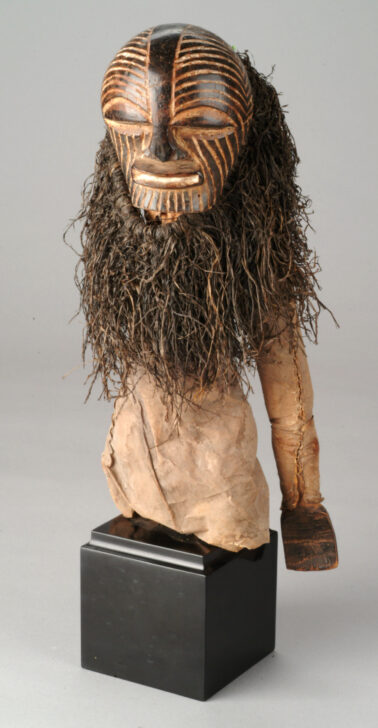Figure
Luba

Description
Subject Matter:
This masked figure is attributed to the Kabongo, a Luba subgroup who lived in the Democratic Republic of the Congo. According to art historian Niangi Batulukisi, the fact that this is a masked figure designed with movable arms makes it a rare, enigmatic piece “in a genre of its own" (121).
Of the several forms of masks worn by the Luba, the one shown in this figure is perhaps the best known and is called a kifwebe (plural, bifwebe). These striated masks with parallel grooves, usually whitened on a dark background, represent spirits and were donned by male and female dancers performing at initiation and circumcision ceremonies, funerals, and rites associated with the arrival of the new moon and the removal of malevolent beings from the community. Batulukisi hypothesizes that this object may have been used as a puppet or as a power figure to combat an illness resulting from initiation rites or circumcision.
References:
A History of Art in Africa. 2nd Edition. Eds. Monica Visona, Robin Poynor, and Herbert Cole. Upper Saddle River, NJ: Pearson Education, Inc., 2008.
Maurer, Evan M. and Niangi Batulukisi. Spirits Embodied: Art of the Congo, Selections from the Helmut F. Stern Collection. Minneapolis: The Minneapolis Institute of Arts, 1999.
Physical Description:
This Luba Kabongo work depicts a half-figure wearing a striated mask, known as a kifwebe. Decorated with kaolin (white clay) and black pigment, the anthropomorphic mask features a round, convex forehead, a vertical ridge running down from the forehead and forming the nose, long, narrow eyes, and, a wide, rectangular mouth. A highly dense fringe of vegetable fiber encircles the wooden face, completing the mask. A shirt stitched of monkey skin covers the figure’s body and existing arm (one arm has broken off); the uncarved hand is exposed and resembles a paddle. Interestingly, the arms have been designed to be movable, suggesting that this may have been used as a puppet.
Usage Rights:
If you are interested in using an image for a publication, please visit https://umma.umich.edu/request-image/ for more information and to fill out the online Image Rights and Reproductions Request Form.